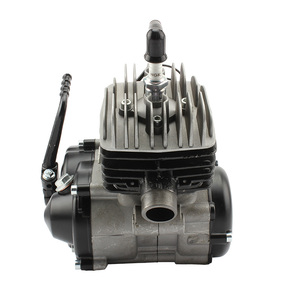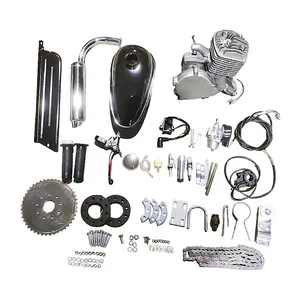(38497 products available)































































































































































































































The term bike engine refers to the power-generating unit in motorbikes and bikes. It is the core part of a motorcycle that converts fuel into power to make the motorcycle move. Different motorbikes require different kinds of engines depending on their performance and usage needs. Below are some common and popular types of bike engines:
Two-stroke engine
A two-stroke engine is an internal combustion engine that requires two strokes of the piston to complete one cycle. It is known for its simplicity, lightness, and ability to generate power with every revolution of the crankshaft, making it a popular choice for dirt bikes and some scooters. In detail, this engine completes an entire power cycle in only two strokes or two movements of the piston up and down. This means that the crankshaft will make a complete rotation once the engine generates power and torque. As a result, this engine type is lighter and more powerful, making it ideal for off-road bikes and smaller scooters.
Four-stroke engine
A four-stroke engine is an internal combustion engine that requires four strokes or two cycles of the piston to complete one power cycle. It is known for its fuel efficiency, durability, and reduced emissions compared to a two-stroke engine. In detail, a four-stroke engine generates power every two revolutions of the crankshaft (every 720 degrees). This means the crankshaft has to rotate twice to complete one power cycle. This results in an engine that is heavier but more fuel-efficient and produces less exhaust smoke.
Single-cylinder engine
A single-cylinder engine is an internal combustion engine that has only one cylinder and piston. It can be a two-stroke or four-stroke engine and is known for its simplicity, lightness, and cost-effectiveness. It generates power with every revolution of the crankshaft. This make motorcycles with single-cylinder engines lighter and easier to handle, especially in heavy traffic or when navigating through narrow streets.
Multi-cylinder engine
As the name suggests, a multi-cylinder engine has more than one cylinder and piston. It can be a two-stroke or four-stroke engine. It is known for its smoothness, higher power output, and better performance at higher speeds compared to a single-cylinder engine. This engine type is common in larger bikes, including sport bikes and cruising motorcycles.
Bike engines are utilized in different scenarios and applications. Here are some common usage scenarios:
Several factors will affect the choice of a bike engine. These include:
Cost
Building a cost-effective engine is important for making sure that the motorbike is affordable to the customers. A good balance between cost and performance should be struck.
Purpose
The purpose of the motorcycle will influence the kind of engine that is put in it. A two-stroke engine may be ideal for off-road motorcycles since it provides quick power. A four-stroke engine is better suited for on-road and long-distance motorcycles since it is more fuel-efficient and has better torque. In addition, for motorcycles that need to be transported at a lower price and can be used for various applications, a versatile engine like a diesel engine may be more appropriate.
Fuel Efficiency
Another important factor is fuel efficiency. Consumers are always looking for ways to save money on fuel. Therefore, engines with better fuel efficiency will be more desirable.
Maintenance
Buyers will want to know how much motorcycle engine maintenance will cost and how often it will be needed. Engines that require less maintenance will be more appealing to customers since they will save them time and money.
Engine Size
Smaller engines, which are usually more fuel-efficient and generate less pollution, are ideal for urban settings. They are simpler to maneuver and have a tendency to be more affordable. Larger engines, on the other hand, generate more power and are better suited for long-distance travel and commuting across various terrains.
Engine Cooling
Another important consideration is engine cooling. Water-cooled engines often need a liquid cooling system, which requires maintenance but offers consistent cooling in high-stress conditions. On the other hand, air-cooled engines are easier to maintain since they do not require additional components for cooling.
Engine bicycles' main function is to provide an efficient and cost-effective mode of transportation for recreation and delivery services. The inclusion of an engine enhances the bike's performance, making it more attractive to customers seeking a dependable and economical mode of transport.
Q1: Can a bicycle be converted to a motorbike?
A1: Yes. A bicycle can be converted into a motorbike using a conversion kit. The conversion kit includes an engine, a chain, a clutch, a sprocket, a fuel system, and wiring. Purchase an affordable bicycle and a cost-effective conversion kit.
Q2: What is the fastest bicycle motor?
A2: The 2-stroke engine is the fastest and most powerful engine in a bicycle motor kit. It has a top speed of 50 mph. The 2-stroke engine is lightweight, and the conversion process is fast and easy.
Q3: How much does it cost to put a motor on a bicycle?
A3: The cost of putting a motor on a bicycle depends on the cost of the conversion kit and the bike. An electric bike engine2 kit costs about $1000. This cost includes the conversion kit and the bicycle. For gas-powered motorbike kits, a gas-powered motorbike kit costs between $200 to $300. In general, the cost of a conversion kit ranges from $200 to $1000, depending on the engine's power and the bike's quality.
Q4: Can a bicycle have an engine?
A4: Yes, a bicycle can have an engine. A bicycle with an engine is called a motorbike or motorcycle. A bicycle can have a small engine of about 40cc to 80cc. The engine is small and lightweight, making the bicycle easy to ride and handle.